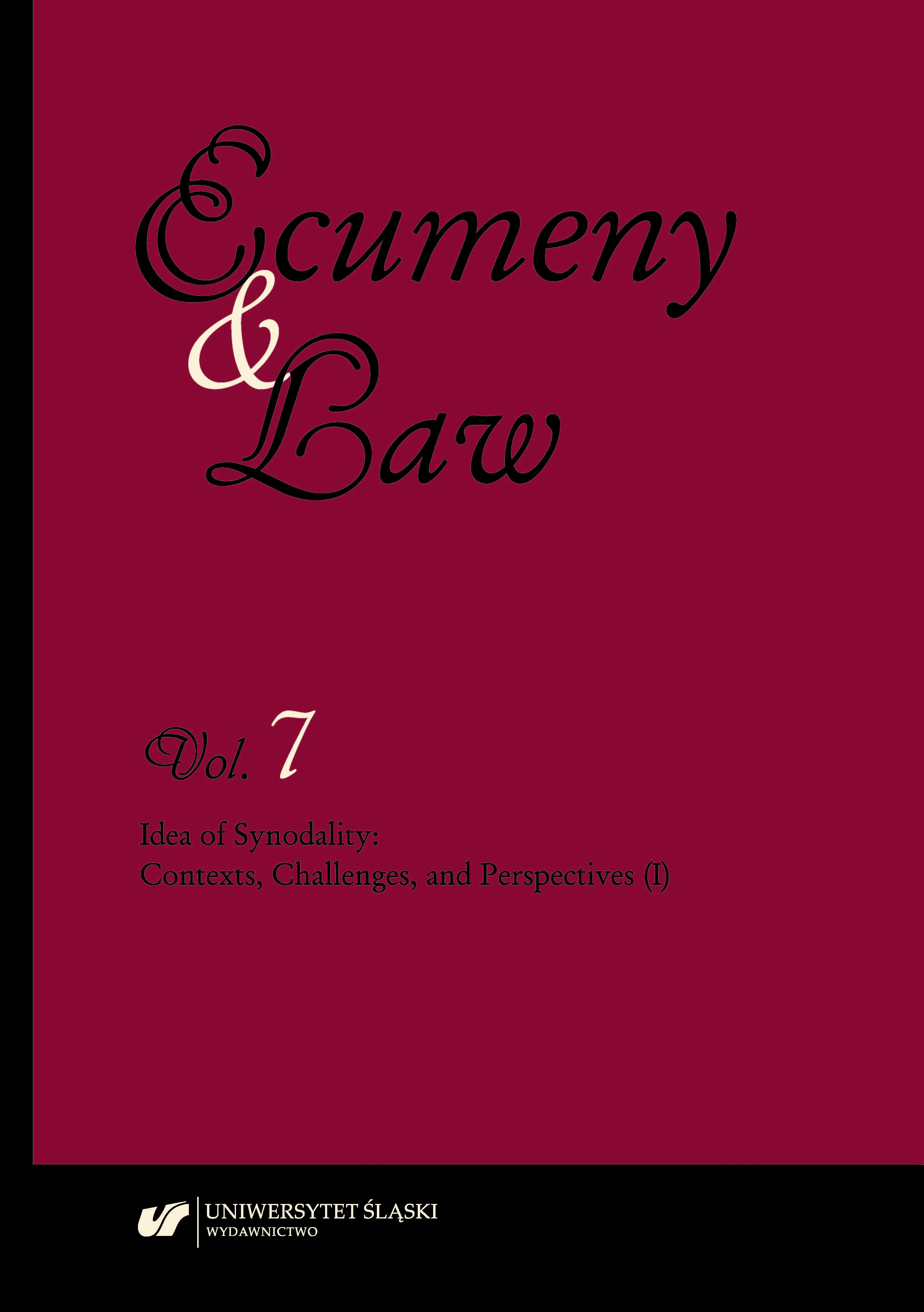Bibliography
Google Scholar
Amenta P.: “Il sinodo diocesano quale organo di partecipazione alla potestà legislativa del vescovo.” Periodica 84 (1995), pp. 639—651.
Google Scholar
Coccopalmerio F.: “Il sinodo diocesano (can. 460—468).” In: Raccolta di scritti in onore di Pio Fedele. Perugia 1984, pp. 407—416.
Google Scholar
CODEX IURIS CANONICI auctoritate Ioannis Pauli PP. II promulgatus, AAS 75/II (1983); Polish text: Codex Iuris Canonici auctoritate Ioannis Pauli PP. II promulgatus. Code of Canon Law. Polish translation accepted by the Polish Episcopal Conference. Pallotinum 1984.
Google Scholar
Congregatio pro Episcopis: Direttorio per il ministero pastorale dei vescovi “Apostolorum Successores” (22.02.2004), Città del Vaticano 2004; Polish text: Congregation of bishops: “Dyrektorium Apostolorum successors o pasterskiej posłudze biskupów.” In: Ustrój hierarchiczny Kościoła. Wybór źródeł. Ed. W. Kacprzyk, M. Sitarz, Lublin 2006, pp. 517—711.
Google Scholar
Congregatio pro Episcopis, Congregatio pro Gentium Evangelizatione: De synodis dioecesanis agendis Instructio (7.07.1997). AAS 89 (1997), pp. 706—727.
Google Scholar
Corbellini G.: Il sinodo diocesano nel nuovo Codex Iuris Canonici. Roma 1986.
Google Scholar
Corecco E.: “Ius universale — ius particolare.” In: Ius in Vita et in Missione Ecclesiae. Acta Simposii Internationalis Iuris Canonici occurente X Anniversario Promulgationis Codicis Iuris Canonici Diebus 19—24 Aprilis 1993 in Civitate Vaticana Celebrati. Libreria Editrice Vaticana 1994, pp. 551—574.
Google Scholar
Corecco E.: “Struttura sinodale o democratica della chiesa particolare.” In: Miscellanea en honor de J. Becerril y A. Miralles. Madrid 1974, pp. 269—299.
Google Scholar
“Dekret O pasterskich zadaniach biskupów w Kościele Christus Dominus.” no. 36. In: Sobór Watykański II. Konstytucje, Dekrety, Deklaracje. Polish text, Pallotinum 1967.
Google Scholar
Feliciani G.: “Corresponsabilità ecclesiale nella struttura gerarchica della Chiesa.” In: Comunione ecclesiale e strutture di corresponsabilità. Eds. J. Beyer, G. Feliciani, H. Müller. Roma 1990, pp. 37—51.
Google Scholar
Góralski W.: “Charakterystyka i ocena II Polskiego Synodu Plenarnego i współczesnych synodów diecezjalnych w Polsce.” In: II Polski Synod Plenarny a synody diecezjalne. Eds. J. Krukowski, M. Sitarz, A. Pastwa. Lublin 2015, pp. 23—51.
Google Scholar
Góralski W.: “Instytucja synodu w Kodeksie Prawa Kanonicznego Jana Pawła II.” Prawo Kanoniczne 31 (1988), nos. 3—4, pp. 35—44.
Google Scholar
Góralski W.: Wprowadzenie do historii ustawodawstwa synodalnego w Polsce. Lublin 1991.
Google Scholar
Góralski W.: “Czy synody są nadal szansą dla Kościoła?” Homo Dei 61 (1992), nos. 1—2, pp. 1—8.
Google Scholar
Góralski W.: “Synod diecezjalny narzędziem odnowy i reformy Kościoła partykularnego.” Kronika Diecezji Sandomierskiej 89 (1996), pp. 472—487.
Google Scholar
Góralski W.: “Ruch synodalny w Polsce po Soborze Watykańskim II.” Roczniki Nauk Prawnych 8 (1998), pp. 239—261.
Google Scholar
Góralski W.: “Ecclesia semper reformanda. W nurcie synodów polskich —wczoraj i dziś.” In: Oddanie i wytrwałość. Recepcja II Polskiego Synodu Plenarnego. Eds. W. Góralski, H. Seweryniak. Warszawa 2004, pp. 41—70.
Google Scholar
Gręźlikowski J.: “Instytucja synodu diecezjalnego w Kościele w Polsce po Soborze Watykańskim II.” Studia Włocławskie 4 (2001), pp. 107—126;
Google Scholar
Konstytucja dogmatyczna o Kościele “Lumen gentium”, no. 22. In: Sobór Watykański II. Konstytucje, Dekrety, Deklaracje. Tekst polski. Pallotinum 1967.
Google Scholar
Longhitano A.: “I sinodi regionali e diocesani: esperienze e prospettive.” In: La sinodalité la participation au gouvernement dans l’Église. Actes du VII Congrès International de Droit Canonique, Paris, Unesco, 21—28 septembre 1990, L’Anné Canonique, hors série (1990), v. 2, pp. 613—622.
Google Scholar
Pawluk T.: Prawo kanoniczne według Kodeksu Jana Pawła II, v. 1: Zagadnienia wstępne i normy ogólne. Olsztyn 1985.
Google Scholar
Pieronek T.: “Posoborowe synody diecezjalne w Polsce.” In: Służyć Prawdzie i Miłości. Pamięci Księdza Biskupa Dr. Stefana Baryły, III Ordynariusza Częstochowskiego. Ed. J. Kowalski. Częstochowa 1984, pp. 392—412.
Google Scholar
Pistocchi M.: De synodo diocesana. Taurini 1922.
Google Scholar
Sacra congregatio pro Episcopis: Directorium de pastorali ministerio “Ecclesiae imago” (22.02.1973). Typis Polyglottis Vaticanis 1973; Polish text: Kongregacja Biskupów: Dyrektorium „Ecclesiae imago” na temat pasterskiej posługi biskupów. In: Posoborowe prawodawstwo kościelne (dokumenty prawno-liturgiczne). Prep. E. Sztafrowski, v. 6, p. 1. Warszawa 1975, pp. 15—352 and in: Ustrój hierarchiczny Kościoła. Wybór źródeł, eds. W. Kacprzyk, M. Sitarz, Lublin 2006, pp. 403—516.
Google Scholar
Sitarz M.: “Podstawowe zasady w sprawowaniu władzy ustawodawczej biskupa diecezjalnego.” In: II Polski Synod Plenarny a synody diecezjalne. Eds. J. Krukowski, M. Sitarz, A. Pastwa. Lublin 2015, pp. 93—117.
Google Scholar
Sobański R.: Nauki podstawowe prawa kanonicznego. Teoria prawa kanonicznego, v. 1. Warszawa 2001.
Google Scholar
Sztafrowski E.: Podręcznik prawa kanonicznego, t. 1. Warszawa 1985.
Google Scholar
Sztafrowski E.: “Synod diecezjalny w doktrynie soborowej i jej wyraz w posoborowych synodach polskich.” Prawo Kanoniczne 30 (1987), no. 1—2, pp. 61—75.
Google Scholar
Wójcik W.: “Synod diecezjalny w nowym Kodeksie Prawa Kanonicznego.” Prawo Kanoniczne 29 (1986), nos. 1—2, pp. 93—122.
Google Scholar


 https://doi.org/10.31261/EaL.2019.07.01
https://doi.org/10.31261/EaL.2019.07.01

 10.31261/EaL
10.31261/EaL